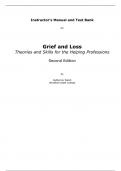Instructor’s Manual and Test Bank
for
Grief and Loss
Theories and Skills for the Helping Professions
Second Edition
by
Katherine Walsh
Westfield State College
,Chapter 1
Introduction to Grief and Loss
CHAPTER SUMMARY
Professionals in every service setting will inevitably encounter clients who
are experiencing grief in reaction to losses. These losses will include deaths
of significant others such as parents, children, grandparents, partners,
classmates, coworkers, and friends as well as losses that do not result from
death but are considered symbolic losses. Despite the fact that we will all
encounter loss and grief in our work, relatively few helping professionals
report feeling adequately prepared in their training to effectively address the
complex needs of grieving clients. Without training in grief and loss, even
seasoned mental health professionals may have difficulty identifying and
responding effectively to grief-related problems that clients present. This
text and the accompanying exercises and resources available on its
companion Web site will help to prepare you to identify and address grief-
related needs from a variety of perspectives, in a wide array of service
settings.
CORE COMPETENCIES IN THIS CHAPTER
Competencies in bold are addressed significantly in this chapter.
Professional Ethical Critical Diversity in Human Rights
Identity Practice Thinking Practice & Justice
Engage,
Research
Human Policy Practice Assess,
Based
Behavior Practice Contexts Intervene,
Practice
Evaluate
CHAPTER OBJECTIVES
• Recognize that different loss experiences generate grief reactions
• Identify types of tangible losses that generate grief reactions
• Discuss the role of helping professionals in engaging clients
experiencing grief.
© 2012 Pearson Education, Inc. All Rights Reserved.
1
,SUGGESTED DISCUSSION PROMPTS
1. Discuss why have you decided to study grief and loss.
2. What kinds of losses have you encountered in the settings you have
worked or studied in?
3. What kinds of reactions to loss have you observed in friends, family or
Co-workers?
4. Were you aware of the terms symbolic and tangible losses and what
examples of each have you observed in your work or personal life?
5. What is the professional role you currently are in, or are training for,
and why is studying grief and loss important for this role?
SUGGESTED CHAPTER ACTIVITIES AND ASSIGNMENTS
1. Identifying Loss and Grief: This exercise is intended to help you
identify the kinds of losses and grief reactions you may encounter in
your internship or practice setting. You can complete this as an
individual exercise, as a classroom exercise, or as an online discussion
in your training program.
• If completed as an individual: use a piece of notebook paper and
a pen.
• If completed as part of a threaded online discussion, each
individual can enter his or her own contributions as well as read
those of other contributors.
• If completed in the classroom, break into small groups of 3, 4 or
5 students.
• Use large sheets of self-adhesive flip-chart paper or large
newsprint sheets that can be displayed on the wall with masking
tape (one for each group of students) and wide tipped felt
markers so the writing will be visible to all. When steps 1, 2 and
3 have been completed, post the sheets around the room and
complete step 4 as a whole class.
• Write on the top of the sheet the types of settings you (or your
group members) are currently working in or hope to work in.
Divide the rest of the sheet into two columns. (For example, an
elementary school, correctional facility, outpatient clinic)
• In the first column, write down the types of losses, both actual
and symbolic that clients you are working with are likely to
experience. (For example, if the setting is a school, actual losses
might be death of a faculty member and symbolic losses might
include children whose parents are divorcing)
• In the second column, next to the loss, write the emotions
someone experiencing that loss is likely to experience
© 2012 Pearson Education, Inc. All Rights Reserved.
2
, • Discuss your thoughts about how you might observe these
losses and feelings related to them being addressed in the
setting (for example, a school counselor leads a group for
children whose parents are divorcing)
2. Self-assessment: On the PBS Website, “On our own Terms”, there are
a number of educational resources for both professionals and families
dealing with death. Included under “ End-of-lifeTools” is a Self-
assessment of Your Beliefs about Death and Dying. You can find the
link on the web page for this text or go to the link below
http://www.pbs.org/wnet/onourownterms/articles/quiz.html to take
the test. After you take the test, write a one-page narrative on what
you have learned about yourself and your beliefs about death from
taking this test.
3. Video: The following videos are available through most video rental
outlets including Netflix. Each of these depicts both tangible and
symbolic losses. Choose one to view and as you watch, make note of
how the characters manifest grief in reaction to tangible losses (due to
death) and symbolic losses. Discuss your observations.
• Videos: Stepmom, Antwone Fisher, My Life as a House,
© 2012 Pearson Education, Inc. All Rights Reserved.
3




